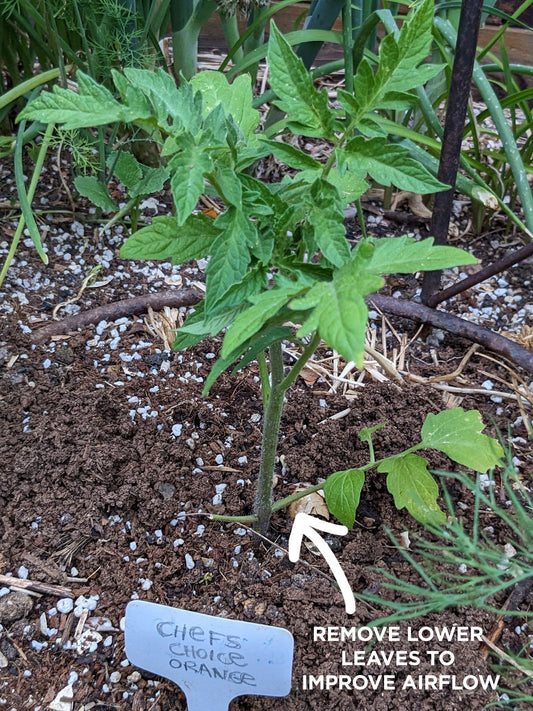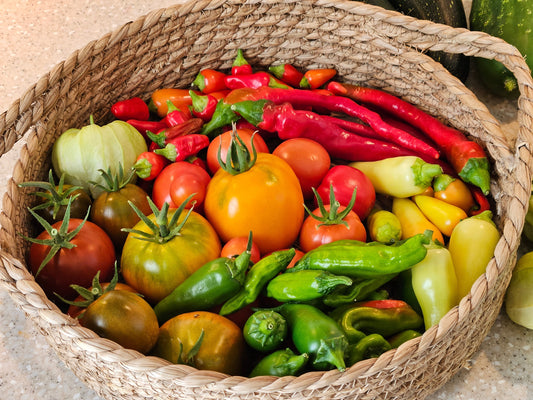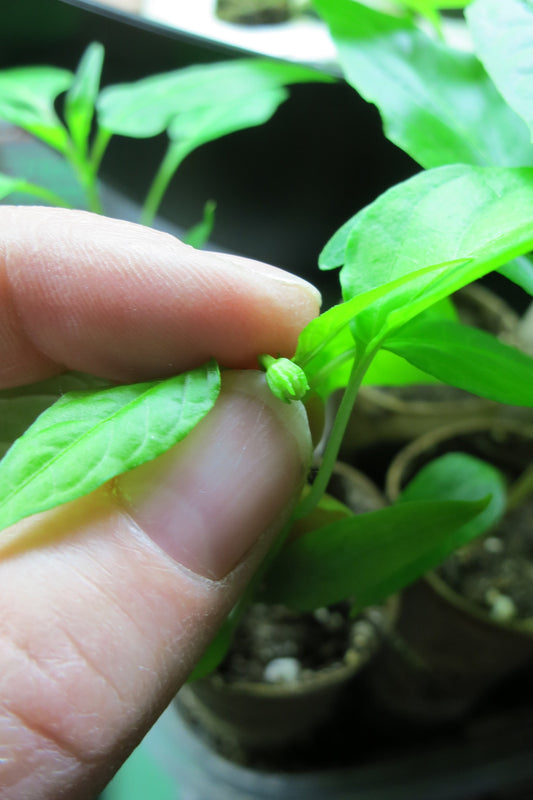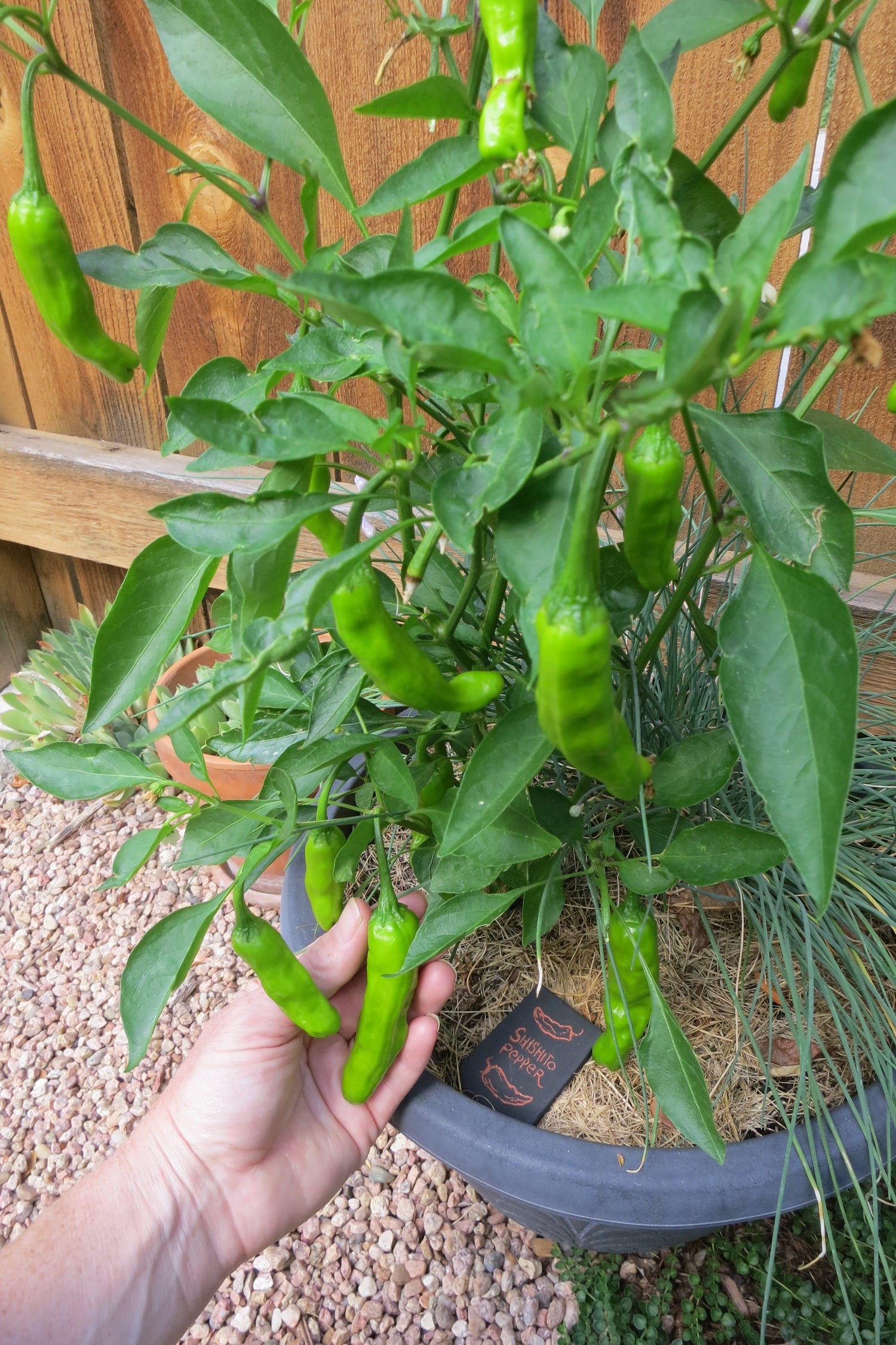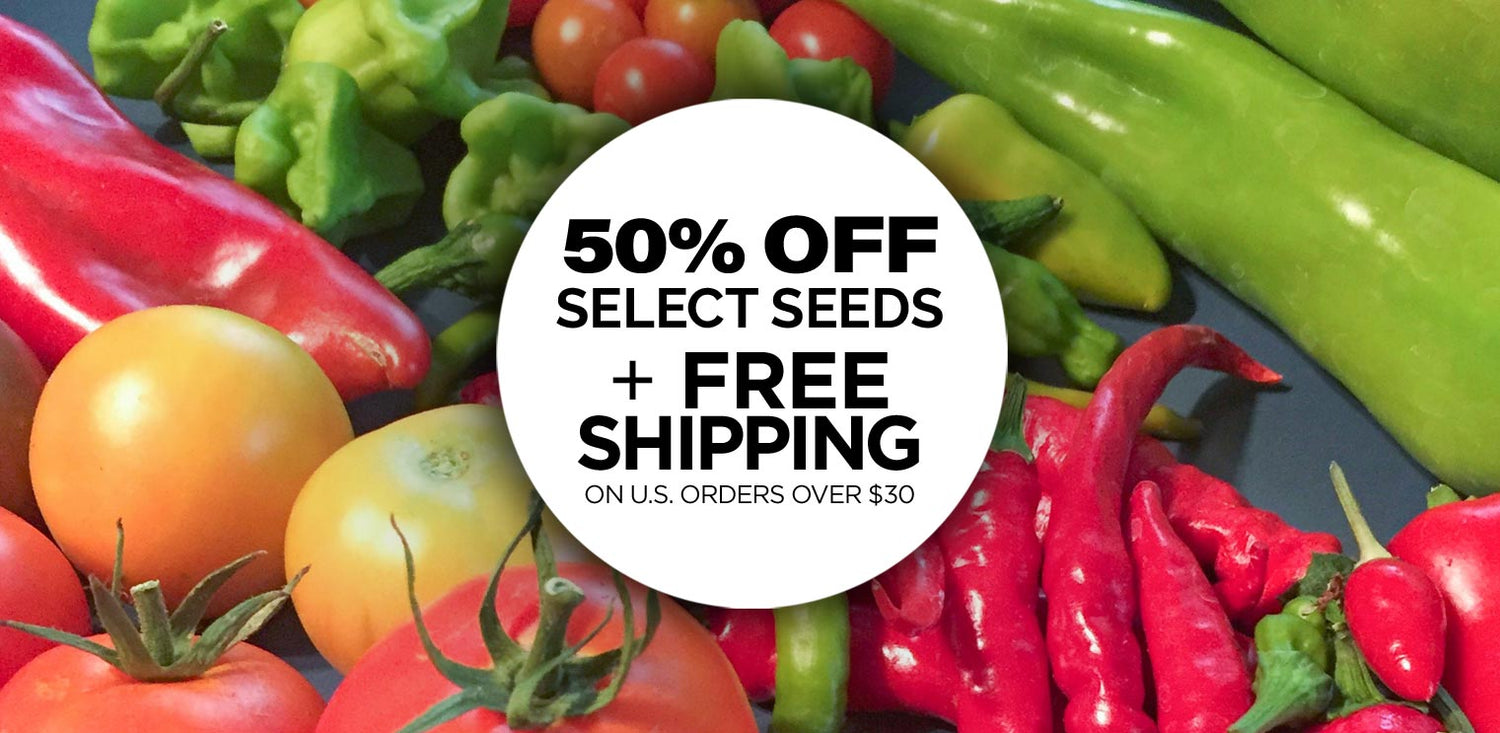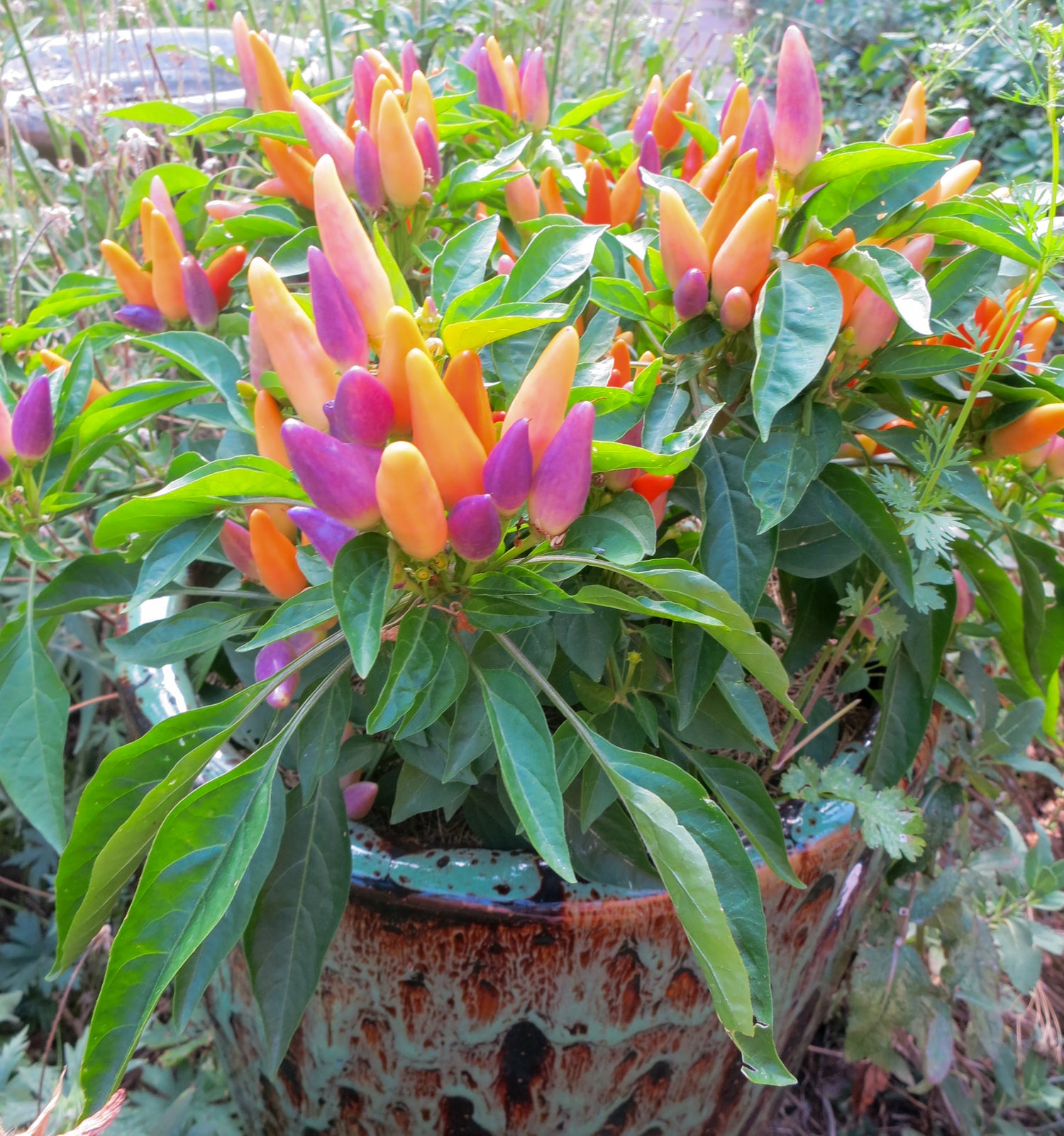
If you're wondering how to grow chilli plants faster, there are a lot of ways to do this. Make sure to start your seeds early, keep them warm, and use season extenders or indoor lights to help them grow faster until the warm weather comes to stay. Make sure to grow them in full sun, too, as peppers need lots of sun to grow big and strong. Read more of our top tips for How to Grow Chilli Plants Faster below...
Here are our top tips to grow chilli plants faster:
1. Grow Short Season Peppers
Choosing faster growing chile plants with shorter growing seasons will help you get your harvest faster. Many of our Jalapeno seeds are fast growing, but you'll find that super hot peppers don't grow as fast, so make sure to try any of the following peppers if you want a quicker harvest. The following short season peppers are some of our favorite chile pepper varieties for faster growing plants:
Our Earliest Pepper: Sweet Chocolate Bell Pepper
This new addition to our seed lineup is the earliest pepper we carry at Sandia Seed! Sweet Chocolate Bell Pepper seeds grow into robust plants quickly with delicious 3-4" chocolate-colored bell peppers are ready for harvest just 57 days after planting! That means these are the earliest pepper seeds we carry!
Early Jalapeño Seeds – One of our favorites as it's perfect for everything from salsas to cutting in half and filling with cheese to roast on the grill. At just 65 days to harvest, these are also one of the fastest growing peppers.
Orange Spice Jalapeño Seeds:
These turn orange when fully ripe and are super fast growing, they're ready for harvest in 65 days from planting the seeds.
Lemon Spice Jalapeño Seeds:
This fast growing yellow jalapeño is joining in on the popularity enjoyed by colorful bell peppers. Use this beautiful pepper to enhance the look of everything you would make with green jalapeños! These yellow jalapenos are also one of the fastest growing peppers, growing quickly and ready to harvest at just 65 days. They also keep bearing all season.
Fushimi Pepper Seeds – Fushimi chile peppers be harvested earlier than most other peppers, and are very prolific the entire season, so you'll be harvesting them all summer. You can cook these up with a little sesame oil and salt in a hot frying pan, they are also great when grilled or pickled!  Shishito Pepper Seeds – Shishito peppers are an early season sweet pepper and are 3” - 4" long on very productive 24" tall plants. Easy to grow in full sun and fertile soil.
Shishito Pepper Seeds – Shishito peppers are an early season sweet pepper and are 3” - 4" long on very productive 24" tall plants. Easy to grow in full sun and fertile soil.
This Japanese heirloom sweet pepper is becoming very popular and in great demand at farmer's markets! It has great flavor and is easy to prepare – we think it has a wonderful salty flavor on it's own, and if you stir fry it with some olive oil, and salt and a splash of lemon, you'll be in heaven. This is also one of the earliest peppers, harvesting in just about 60 days, and then they continue to produce lots of Shishitos until frost.
For faster chile pepper harvests, visit our
Fastest Growing Peppers Seed Collection: 
 Mild Hatch Green Chile NM 6-4 Seeds – The most popular Hatch green chile to grow because of its mild heat content and it matures early and grows well in short seasons. Hatch Green Mild - NM 6-4 has always been the standard for open-pollinated mild green chile. (70 days from seed to first harvest).
Mild Hatch Green Chile NM 6-4 Seeds – The most popular Hatch green chile to grow because of its mild heat content and it matures early and grows well in short seasons. Hatch Green Mild - NM 6-4 has always been the standard for open-pollinated mild green chile. (70 days from seed to first harvest).
This early hatch chile has thick fleshy walls and grows on 30” plants. A large amount of this Mild Hatch Green Chile can be added to recipes for delicious and traditional flavor and aroma with mild heat and not the burn of hotter varieties.
On a side note... Read a little more about the famous Hatch Chile...
Hatch chiles are famous around the world for being the most flavorful chiles you can grow. They're hard to find outside of the New Mexico region, where they have been grown for centuries. Each season, the Hatch chile growers all run out of their highly-desired chiles and there is a fall scramble to stock up freezers for a year's worth of use. It's so easy to grow Hatch Chile Seeds, however, we encourage gardners to grow their own so they have their own fresh supply of chiles through the entire harvest season from the first chiles to the last.
By the way: technically, if you don't grow these varieties in the Hatch region of New Mexico, then you can't call them Hatch chiles. But we think they still taste great no matter where you live in the world!! Especially if they're home-grown. :) Learn more: What makes a Hatch Chile Hatch?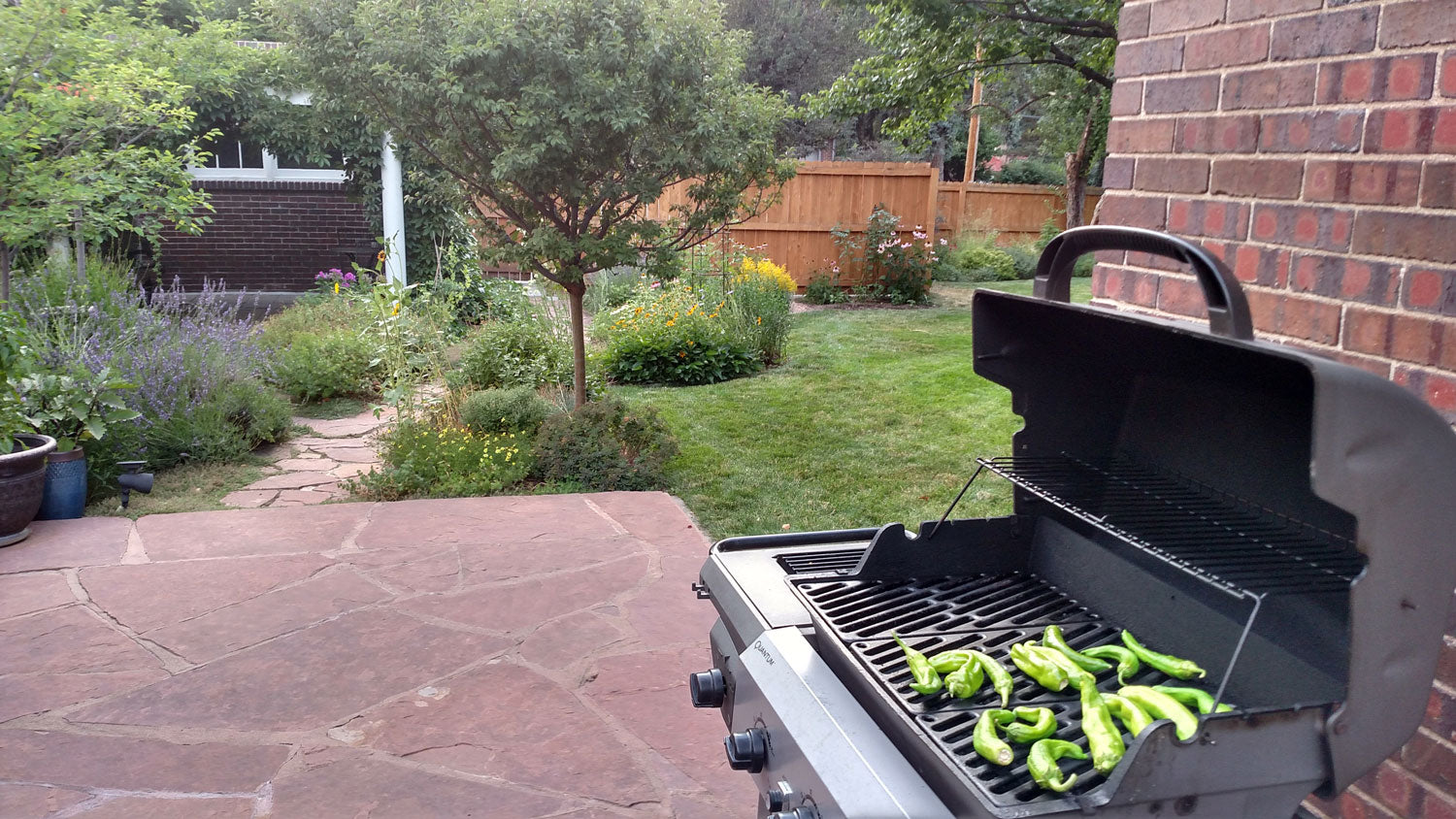
When roasted, the flavor of Hatch chiles intensifies and they are wonderful on everything from pizza to burgers to green chile stew. Roasting also makes it easy to peel the skins off of the chiles. Roasting can be done on the grill or over an open flame on your stove. Make sure to check out some of our chile recipes in our blog »
2. Start EARLY!
Start your seeds indoors as early as you can, and grow them using a sunny window and/or with supplemental light to help them get a head start before it warms up enough outside to transplant into your garden or large containers. The lights should be close to the seedlings, within 6" or so, keep an eye on them so the lights don't burn the plants! Make sure to keep the seeds super warm when germinating, they ideally like temperatures between 80-90˚ F to sprout the fastest. We use heat mats for our seedlings which really helps keep them warmer. Do NOT keep pepper seeds in an unheated greenhouse (even with a heat mat), as the nighttime temperatures could affect germination – the heat must be consistent for best germination rates. Keeping them consistently warm will also help them grow faster.
Leggy Pepper Plants
To encourage your pepper plants to grow stockier and stronger, it's important to simulate the natural breezes that they would otherwise get outdoors. We will pet or brush them with our hands daily, and / or you can also run a fan on them for a few hours a day. This will encourage the stems to grow stockier and studier, and they won't get so leggy. Read more about Leggy Pepper Plants »

We like to have peppers at least one month old before the transplanting outside after it's warmed up to 60˚ consistently, day and night. When it's warmed up, and after all chance of frost has past (unless you're using Water Walls or hoop houses), you can transplant the plants outside.
Don't forget to harden off your pepper plants before transplanting outdoors. This is done by taking them out for short periods of time at first, and gradually increasing their time outside over a few days to a week. This will help their stems get stronger with the breezes, and help them adjust to the much brighter outdoor sun and temperature swings.

Another hint: We typically remove the earliest flowers to allow plant to grow bigger and produce a lot more peppers in the long run. Learn more about How to Prune Pepper Plants for Maximum Yield »
Find lots more tips about how to grow peppers from seed »

3. Use Water Walls or Greenhouses or Hoop Houses:
 Water walls are great season extenders and work especially well with peppers. They are simply plastic "walls" filled with water that form a teepee over your seedling and keep the temperature warm at night and even warmer during the day, using solar heat. When we put these on our pepper seedlings in the spring, they're twice as big as their unprotected counterparts.
Water walls are great season extenders and work especially well with peppers. They are simply plastic "walls" filled with water that form a teepee over your seedling and keep the temperature warm at night and even warmer during the day, using solar heat. When we put these on our pepper seedlings in the spring, they're twice as big as their unprotected counterparts. We usually take the water walls off after it has warmed up to 60˚F or warmer at night.
You can also use a greenhouse or hoop houses to keep your peppers warm and protected during the cool-weather of spring. These also help of course with spring hail storms. Keeping your peppers warm is the most important thing for fast growing. Some people warm their soil with black plastic in early spring to use the solar heat to warm the soil to prepare for planting peppers.
Note: There are two cooler weather peppers that don't mind it cold: The orange Manzano Pepper, and the Bulgarian Carrot Pepper – both are quite spicy! These are great if you live in cooler regions such as the mountains.

Use Compost! Making your own compost from grass clippings, leaves, and kitchen waste is a great way to improve your soil to help your chile pepper plants thrive. We think compost is the BEST fertilizer of all, because it's alive with worms and other organisms that provide nutrients to your plants. Adding compost to your garden beds throughout the season is a great way to improve your soil's organic matter which eliminates the need of adding fertilizers. We like to bury compost under each of our plants, then backfill with soil. This allows the plants' roots to grow into the buried compost and it provides nutrients all season long. You can also top dress with aged compost around your garden during the summer, don't put it too close to the stems as compost can burn plants. We also like to mulch our peppers with grass clippings or leaf mulch to help retain the soil moisture to reduce watering needs. This mulch also keeps the soil temperatures more stable, and feeds the worms and other organisms that, in turn, feed your chile pepper plants.
Read more about Composting for HUGE Green Chiles »

4. Another way to Grow Pepper Plants Faster is to start with a full grown plant every year! How do you do this?
Overwinter* your Pepper Plants!
Did you know that many hot peppers are long-lived plants? Some plants can live for 5-10+ years. The trick is to not let them freeze, most peppers hate cold weather and start to wither when temperatures get below 50-60˚F. So, if you have a bright sunny window, or supplemental lighting, you can either bring in your potted peppers indoors or transplant ones out of the garden into indoor pots (we usually prune them back to encourage root development after transplanting). You can also Clone your peppers to help reduce the chance of bringing pests inside. Just pick a healthy 6" stem, remove leaves, put into water for a couple weeks to start rooting, then transplant into good well-draining potting soil or a hydroponic system and grow indoors over the winter months. Some people dust the bottom of stems with rooting compound before putting into soil to help roots develop faster. We find they root better under supplemental light or indirect bright light versus sunlight from windows until they're more rooted. Make sure not to overwater them and keep them in a bright location over the winter months. Transplant or bring outdoors when the temperatures warm up to 60˚F or warmer, even at night. Don't forget to harden them off first by bringing them out for a few hours a day for a week before leaving them outside overnight. Then after they've spent a night or several outside, plant them in the evening or in the early morning so they're not shell-shocked by mid-day sun. Water in, but don't overwater them! Chile Peppers are notorious for "drowning" from overwatering provided by good intentioned gardeners.
* While many of the super hot peppers (like the Carolina Reaper or the Trinidad Scorpion) do well with overwintering, not all peppers are suited to it. We do not find that Hatch Green Chiles do well with overwintering, we tried overwintering Hatch Chile peppers in Albuquerque. We took them out of the ground and into 5 gallon buckets. All the leaves fell off and they went dormant, and it was a big mess. They were alive and grew new leaves in the spring but were stressed and never did have a full bloom of flowers and few peppers. But, maybe if they were cloned or were already in containers, they could over winter better inside. We also think that strong supplemental lighting is needed for good winter growth to keep them bushy and thriving. We usually just try to start our Hatch seeds super early to get a lot of growth before transplanting outdoors. Have any of you overwintered Hatch Green Chiles with success? Contact us and let us know, we love seeing your gardening projects.
Hydroponics:
Hydroponics is another way to grow peppers faster. Pepper plants grown this way can be highly productive for about three years, which is about the time the pepper starts to decline with less fruit and less quality peppers. Older pepper plants will still produces (with more decline) but many can be kept growing indefinitely.

We sometimes use toilet paper roll pots for chile peppers »
Find tons more info on
how to grow peppers from seed »
P.S. Regarding the spelling of "Chilli" in the title of this blog post, we know Chile is the correct way to spell it, at least in our neck of the woods. But around the world, the spelling varies, you'd be surprised how many people search for "Chilli" plants which is why we named the post with that spelling to help them find it. It's ok, as long as you're growing chiles, we think you're perfect. ![]()


